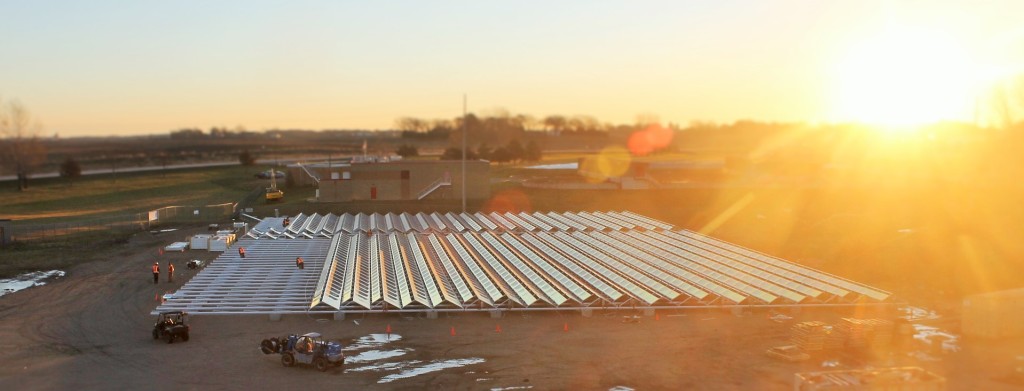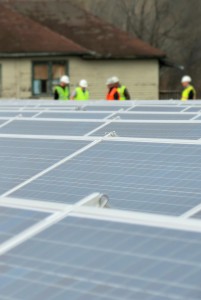Hutchinson Completes 400 kW Landfill Mounted Solar PV System
While we shouldn’t thank our forefathers for leaving behind landfills and the environmental consequences that accompany them, it is becoming increasingly possible to see some green amongst those brown fields. In Hutchinson, this green to brown transformation is already underway. With a solar field just beginning operations on a former landfill, there is quite a green and golden lining to a brown past.

Workers install the last panels as the sun rises over Hutchinson’s new solar PV project, the largest on a landfill in Minnesota, and the first ballast-mounted on a brownfield.
Made possible by a generous Renewable Development Fund grant from Xcel Energy, Hutchinson will soon be home to the largest landfill solar project in Minnesota. Built on the site of a 1970s era city dump, the 400 kilowatt array will hook directly up to the wastewater treatment plant next door, helping offset energy use for the city’s largest municipal energy consumer. There, it will be used to transform another brown environmental problem blue.
The project has just connected to the City’s wastewater plant’s electric supply, and is undergoing commissioning. A ribbon cutting ceremony is scheduled for Wednesday, December 2. Ameresco, a certified Minnesota Energy Services Company, developed the project and will guarantee the performance of the system until it becomes cost neutral. The hardware and 975 solar panels and hardware are supplied by tenKSolar, one of Minnesota’s premier solar companies, and were installed by Hunt Electric.
As the first of its kind in the state, the grant was awarded so that the project could be a demonstration of statewide potential for solar brownfield redevelopment projects. To ensure safety and aid replication, extra measures have been included to ensure that the landfill site is handled with proper care during installation, operation, and maintenance. One such measure is developing the project to be “non-penetrating” in regards to disturbing the underlying waste materials in the landfill, limiting health and environmental exposures to such materials.

An old building used for the fire training facility at the landfill sits behind workers inspecting the array.
While the type of construction may limit health exposures from the landfill, it cannot control what goes on below the surface. Most landfills, this one included, have a variety of organic and inorganic materials wasting away below the ground. This can lead to what is referred to as “differential settlement,” meaning even a leveled surface may become uneven over time. You can imagine the troubles this may cause for a solar array—the panels are connected to each other and need to be squared up to ensure proper functioning. If the land beneath the panels were to settle unevenly, there is potential that the dimensions would be thrown off and the array sent into disarray.
Luckily, the dump hasn’t been used since the 1980s. The older a landfill is, the less of a problem differential settlement poses. Even so, maintenance parameters are in place to address differential settlement issues that may occur. The system design allows for shims to be placed under the supporting rails if any of the concrete bases settle too much over time.
As Minnesota’s solar industry blossoms, more and more sites will need to be examined for solar potential. The hope is that Hutchinson’s project will help remove the obstacles and insecurities associated with brownfield development by demonstrating just how feasible it is. All parties win when solar developments make brownfields a little brighter instead of taking up valuable greenspace or other productive land.
If you would like to learn more about the solar project, developments of solar on brownfields, or are interested in attending the grand opening ceremony, please contact John Paulson | (320)234-5682) or Jamie Johnson | (320)234-4246).
About the author: Jamie Johnson is a Minnesota GreenCorps member serving with the City of Hutchinson, working on energy issues and efficiency improvements at the local level.

